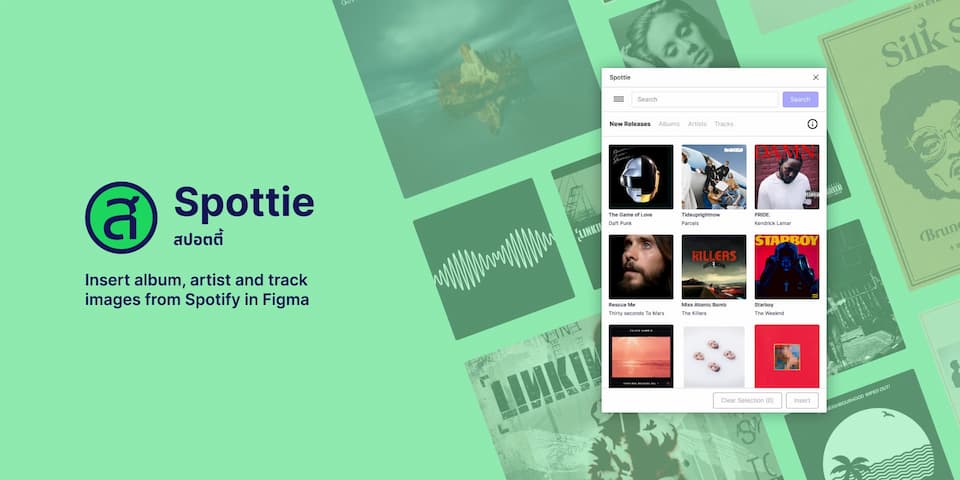My first Figma plugin got published! This is my first open source coding project that I actually completed and released to the public!
In this post, I outlined my process of designing and developing this plugin. This is a condensed overview of my creative and development process. Since this is my first plugin, I was still figuring a lot of things out. So there were lots of going back and forth on testing out proof of concepts, designs and coding. So the real process is a lot more messier than it might seem when you are reading this.
Spottie uses Spotify API to get new release, album and track images which you can can insert directly into Figma. Similar to Unsplash plugin. For this project, I designed the user interface in Figma and wrote all the code with Javascript/HTML/CSS.
How it works
Check out the walkthrough to see how the plugin works.
The primary goal of this plugin is to make designers more efficient. More time on creating and less wasted time going to the browser and searching for images. Spottie is here to help solve that problem! Just search and insert, right in Figma!
Basic usage
- Run Spottie
- Select an image and insert into the canvas
Features
Here are all the main features of the plugin.
- New releases on plugin start up
- Search album, artist and track covers
- Insert single image with single click
- Long press on an image to enable multi-select mode
- Selected object(s) in the canvas will get replaced with the inserted image(s)
- Browser-level image lazy-loading
- In the Tracks tab, double-click on any thumbnail to listen to the preview track!
Proof of concept
Before I even begin to design and code the plugin, I had to make sure that this idea was even feasible. Since the main feature of this plugin required using the Spotify API, so I need the test the API first.
I signed up for a Spotify developer account and tested the search API. The code example below shows "The Killers" as the query input and then the server returns the JSON result.
// Spotify Search endpoint - https://api.spotify.com/v1/search
axios({
method: "get",
url: `https://api.spotify.com/v1/search?q=the+killers&type=artist`,
headers: {
"Authorization": `Bearer ${access_token}`,
"Content-Type": `application/x-www-form-urlencoded`
}
})
.then ( response => {
let res = response.data
console.log(res)
})
// example response data
{
"artists": {
"items": [
{
"images": [
{
"height": 640,
"url": "https://i.scdn.co/image/c85f1ea9f92dc0cc43965a0c727c4a1cdd1c2540",
"width": 640
}
],
"name": "The Killers"
}
]
}
}
Success! I now have the data and validated my idea, so the next step is to develop the plugin.
Designing and coding the plugin
Lo-fi Design
For the design, I looked at other similar plugins first, like Unsplash. Looking at the UI/UX, the interactions and started writing out what I need for my own plugin. So I did a little brainstorming and wrote down the essential features for Spottie, then started designing the first prototype.
Features
- Search bar
- Tab navigation
- Displaying search results
- Search controls
- Inserting images into Figma
I started working on the lo-fi designs in Figma first. This was to test out the placements of the UI elements and interactions.
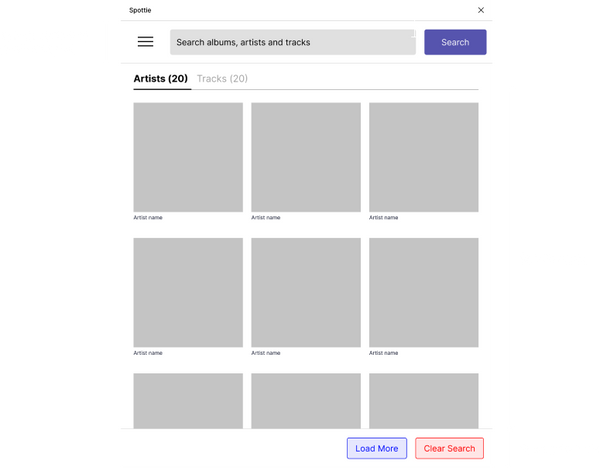
Tech Stack
Before prototyping, I already picked out my tech stack for developing this plugin. I wanted to use Vue.Javascript and Tailwind CSS to create the UI of the plugin so that I can create the interface and the interactions easily and quickly. So when I started this project, I looked for a Figma plugin template that was using Vue.js and I found this template which turned out to work great for creating Figma plugins. So thank you to Manthankumar Satani for this plugin template.


Final Design
With the prototype working, it's time to fully flesh out the rest of the design. I don’t want to say that this is a hi-fi design since it didn’t change much from my initial designs. For my plugins, I try to keep it as simple as possible and also follow Figma plugin best practices. So that means following the Figma's design guideline as much as possible, hence the minimal design.

As you can see from the final design, I adjusted the dimension of the plugin to better accomodate the images and updated the UI to the design guideline. Then I added an Info icon and removed the search result count in the tab. The rest stayed the same as it was working well already.
Building the MVP
To move quickly and release as soon as possble without getting stuck on design and development loop, I had to build and release an MVP version of the plugin. So I made a list of features for the MVP that I want to release first and other features for future updates.
With the final design ready, I coded the rest of the UI and the interactions. This part took the most time because for most of the code I didn’t use any libraries, except for the "long press" which was a bit difficult and time consuming to implement. I had to code most of them which meant lots of bugs and debugging and testing. Multiple selections and multiple inserts were the most complex interaction for this plugin.
Testing, debuggin, testing, debugging...
I approach testing by listing out all the interations here:
- New releases - on plugin startup
- Search - albums, artists and track covers
- Insert single image
- Multi-select mode - Long press on an image to enable
- Multiple image inserts
- Selected object(s) in the canvas will get replaced with the inserted image(s)
- Browser-level image lazy-loading
Since the plugin had lots of interactions, It needed a lot of testing to ensure that all features were working properly before publishing. So it took me about 2 weeks of my free time to test all the features.
Publishing and promoting the plugin
Preparing assets
Now the plugin is ready to be published, but before I can do that I need to prepare all the logos and banner image first. So that took a few more days to get all the assets ready. First I designed the logo, which after going through abstract designs, I thought I would go with a logotype design instead.
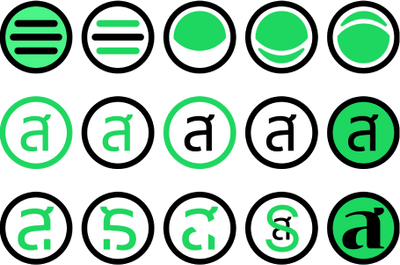
While looking at other plugin logos, I decided that the logotype should be a Thai letter since all the other logotypes were all English Alphabets. I wanted my work to connect to my Thainess in some way, so it seemed appropriate to design the logo this way. So I used the "ส" which is the equivalent of the letter S in the alphabet. This is the final logo design that I ened up with.
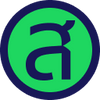
Published!
I felt a huge relief when I hit that publish button 😆. All of the 2 months-ish of hard work that I have done is finally going to be used by real people! But Figma still needs to review the plugin first so that took around 10 business days before it got published to the public.
Getting the word out
Once the plugin has been approved, I can now do some promoting! I prepared some copy-text and started posting on Product Hunt, Facebook, Instagram and Twitter. People started responding and the installs started going up!
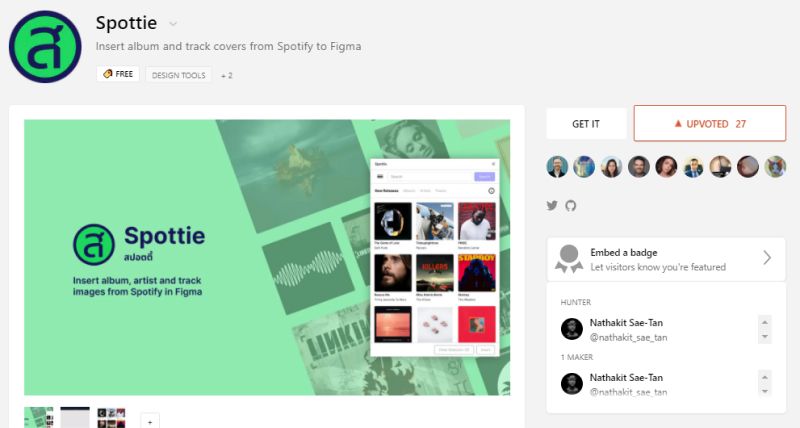
Bug fixes, patches and updates
The work is not done yet! A few days had gone by and even though no one had reported any bugs, I went back to use it again and found some bugs! So I went back into coding mode again. There were issues with the pagination that sometimes were returning duplicate results and Load More button was not disabling correctly. Once the bugs were fixed, I worked on more feature updates since I was already coding. I added the New Releases tab so that users can quickly insert images straightaway without having to search.
Analytics
Spotify provides a dashboard for developers to create and manage integrations. So for this project, I can monitor the API usage for the plugin. As you can see below, the graph shows the total number of requests from the Search and New Releases API when the users were using the plugin.

Open source
Creating open source projects can be very exciting, knowing that people are actually using something that you made is is an awesome feeling. I was so excited I kept checking the install numbers on my Figma profile everyday 😆
For most of my personal projects, I try to make it open source, so that means all the code and assets are available to the public. So anyone can see the code and help improve it or make feature requests or report bugs.
Feel free to open issues/request features or pull requests at https://github.com/nathakits/spottie-figma-plugin
If you think this project is helpful, you can help support me here 🙂 - https://ko-fi.com/nathakits
